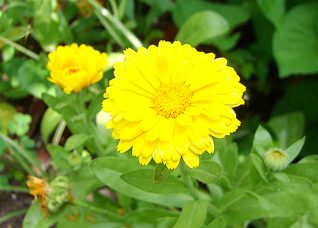
MinerAlert

MinerAlert
Schkuhria pinnata
Asteraceae
Canchalagua, dwarf Mexican marigold, khaki bush, pinnate false threadleaf, schkuhria, starry skies, bitterbossie, chanchalagua, onyalo biro, pichana, pillaguay, tacote, tlanchalagua, yellow tumbleweed (Quattrocchi, 2012; Gupta, 2008; Taylor, 2012; Torkelson, 1996; Smith, 1966).

This annual bushy and weedy herb is native to South America. Canchalagua is an important medicinal and insecticidal plant in various countries, including Peru, Argentina, Bolivia, and Paraguay. Canchalagua has been introduced to various regions of Mexico, the Southwestern United States, and Africa (Alonso and Desmarchelier, 2015; Mabberley, 2008; 2012).
One of the common names used in many Spanish American countries, “canchalagua”, is also used to describe a very different plant species (Centaurium chilensis - Gentianaceae), another medicinal plant native to Chile (Berdonces, 2009).
The whole plant.
The whole fresh plant is sliced and steeped in hot water to make a tea (infusion). In addition, the dried plant can be decocted (boiled in water) and taken as a tea for various ailments (Taylor, 2012).
The plant has a wide variety of medical uses including the following: antibiotic, anti-inflammatory, digestive upset, coughs, diuretic, diabetes, kidney and liver problems, malaria, allergies, varicose veins, fungal (yeast) infections, obesity, prostate inflammation, bloating, diarrhea, rheumatism, skin conditions (acne, dermatitis, and eczema). Te tea is also taken to regulate hormones, urinary tract infections and kidney pain, as well as to help digestion (antispasmodic actions). Externally, a decoction of the plant is applied to the skin as an antiseptic for wounds. In Latin American countries, the plant is dried and pulverized for its use as a household insecticide or, repellant, especial for lice and fleas. Various studies in Africa and Latin America show that the plant possesses antimicrobial action against various bacterial and fungal species (Alonso and Desmarchelier, 2015; Masevhe et al., 2015; Quattrocchi, 2012; Mostacero et al., 2011; Wagate et al., 2010; Duke et al., 2009; Gupta, 2008; Taylor, 2012; Sung, 1996).
A study by Carraz et al. (2015) showed that a crude extract obtained from dwarf marigold demonstrated anti-proliferative actions on Hep3B hepatocellular carcinoma cells, thus corroborating the traditional medicinal use of the plant for the treatment of liver ailments.
Mokoka et al (2013) showed that extracts from various medicinal plants, including dwarf marigold, contained bioactive active ingredients against various protozoan parasites, such as Trypanosoma brucei, T. cruzi, Leishmania donovani, and Plasmodium falciparum.
A study by Deutschländer et al. (2009) found the acetone extracts obtained from dwarf marigold exhibited anti-diabetic activity in vitro, but also showed cellular toxicity, thus raising concern for prolonged treatments.
Methanol extracts of dwarf marigold have been shown to be active against Plasmodium berghei, one of the protozoan parasites that cause malaria in Africa (Muthaura et al., 2007).
A decoction made from the root taken as a tea has been touted as a treatment for weight loss, although no clinical trials to confirm this are presently known (Alonso and Desmarchelier, 2015; Toursarkissian, 1980).
Safety/Precautions:
Before you decide to take any medicinal herb or herbal supplement, be sure to consult with your health care professional first. Avoid self-diagnosis and self-medication: Always be on the safe side!